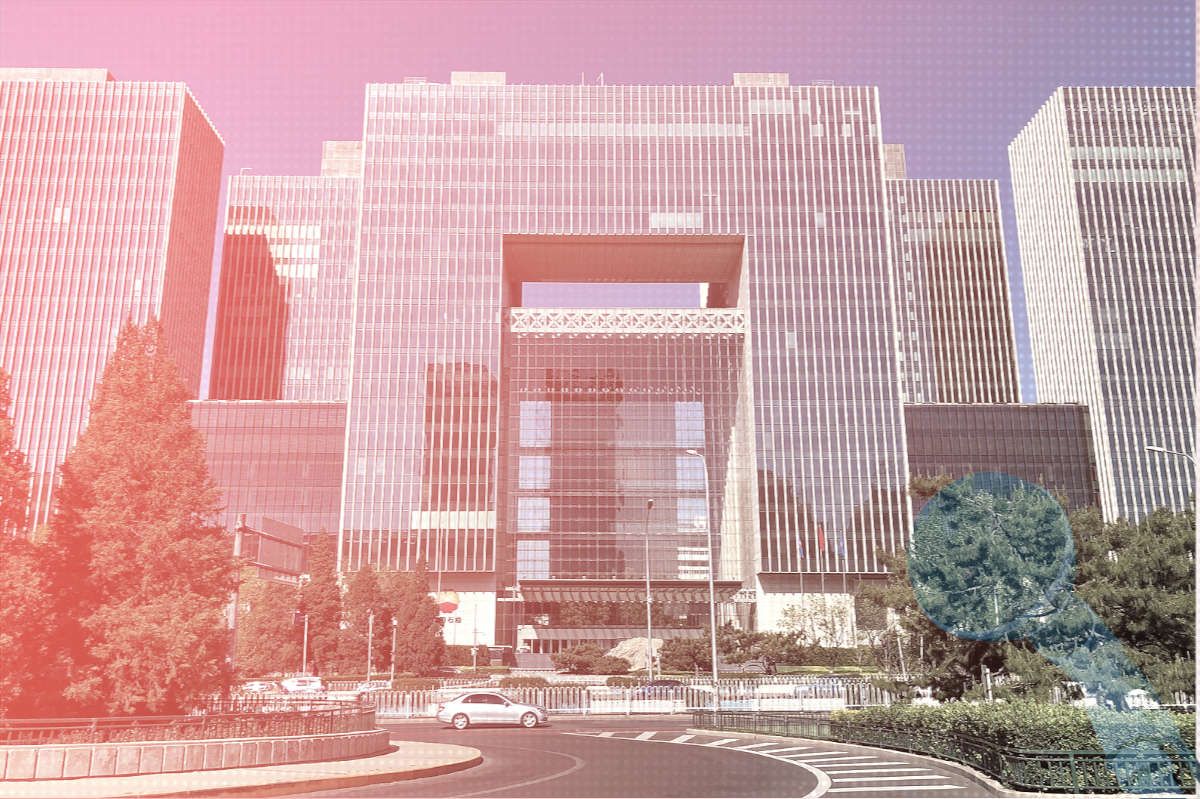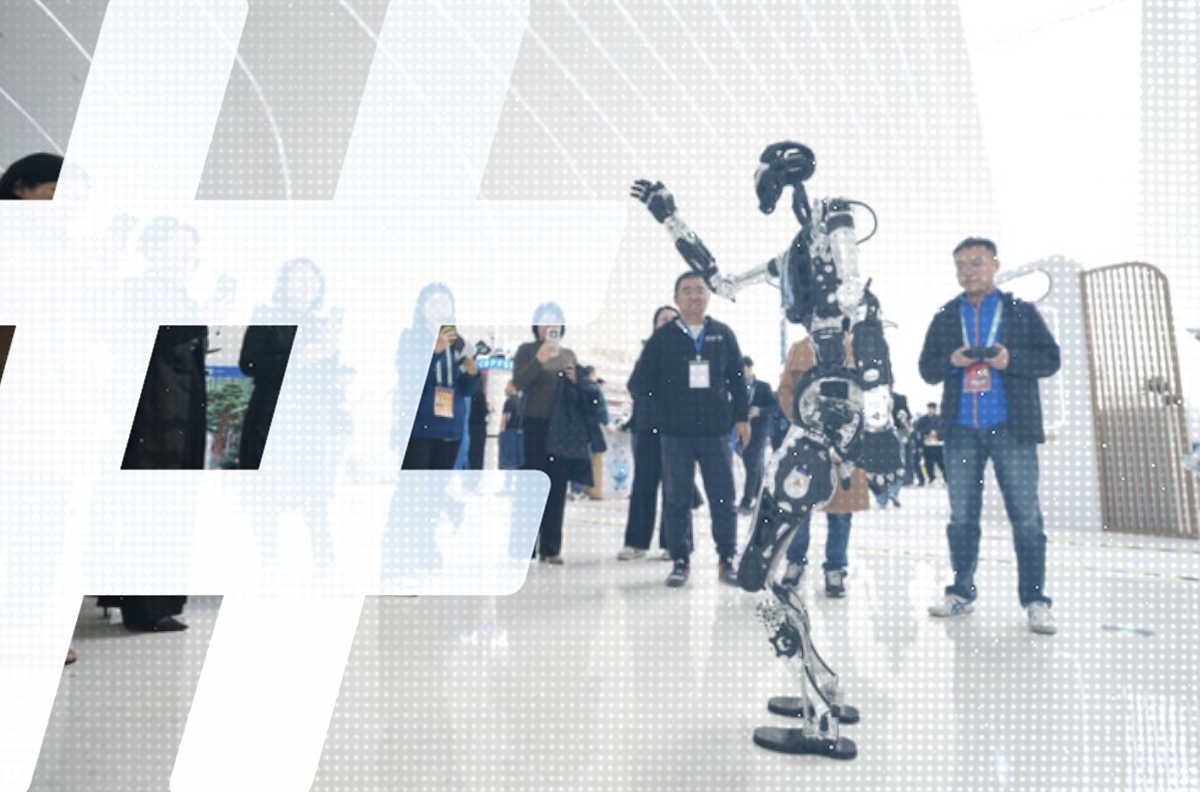Today marks the one-hundredth anniversary of the start of the Xinhai Revolution in China, which overthrew the country’s last imperial dynasty, the Qing, and eventually led to the founding of the Republic of China in 1912. Not surprisingly, China’s newspaper pages today are filled with news of this important anniversary.
But as a major political movement calling for freedom and democracy, and an end to authoritarianism, the Xinhai Revolution is also a highly sensitive issue for the ruling Chinese Communist Party. It is not surprising, therefore, that most of the coverage today sticks quite closely to the official story from Xinhua News Agency. Below the fold are other local stories, such as local commemorations of the Xinhai anniversary, and about a former chief engineer from Boeing making a visit to Wuhan.
We can see the basic Party treatment best by looking at the front page of the Party’s official People’s Daily, where a photo of the standing committee + 1 (former President Jiang Zemin), with Hu Jintao and Jiang Zemin right smack in the middle, accompanies a dry report on the commemoration and the full official text of Hu Jintao’s “important speech.”

Typical of boilerplate Party coverage of official activities, and basically identical to the Xinhua version, the People’s Daily report begins:
Beijing, October 9 — A major conference to commemorate the 100th anniversary of the Xinhai Revolution was held ceremoniously in the Great Hall of the People this morning. General Secretary of the Chinese Communist Party, National President and Chairman of the Central Military Commission Hu Jintao (胡锦涛) made an important speech. He emphasized that 100 years ago, revolutionary Party members represented by Sun Yat-sen (孙中山) launched the Xinhai Revolution, which shook the world, beginning a social transformation such as China had never before seen. Today, we solemnly commemorate the 100th anniversary of the Xinhai Revolution . . .
The report notes, of course, that the rest of China’s powerful politburo standing committee were also in attendance: Wu Banguo, Wen Jiabao, Jia Qinglin, Li Changchun, Xi Jinping, Li Keqiang, He Guoqiang, Zhou Yongkang. But again, Jiang Zemin (江泽民), Hu Jintao’s predecessor as President, and still a powerful political player, is added to the beginning of the name list, given place of pride right after Hu Jintao and before the other 8.
In the People’s Daily, the underlined portion above (and some text immediately following) is emphasized in a bold pull-quote at the top right of the page, a place usually occupied in the newspaper by another major policy announcement.
We’ll avoid the temptation of parsing Hu Jintao’s speech in commemoration of the 100th anniversary of the Xinhai Revolution. In our view, this speech has little political significance in and of itself, the only substantial sign emerging from the commemoration ceremony being the appearance and prominent positioning of former President Jiang Zemin.
Coverage of the Xinhai Revolution anniversary in today’s mainland newspapers seems to follow two basic lines. First, there are the People’s Daily copycats, running coverage and framing coverage in exactly the same way as the chief Party newspaper. This is actually quite typical of what we generally see nationwide, across the board, in the official Party newspapers whenever a single story — such as a national conference or other major national or international event — dominates.
Here is a composite of four major Party newspapers — the People’s Daily, the Liberation Army Daily, Guangming Daily and Economic Daily — made by media microblogger Old Media Wang (传媒老王) today. The affinities should be clear to all.

This “mainstream” treatment of today’s big story seems to have been adopted uniformly across Party newspapers today. The treatment is also used by some commercial metro newspapers. Here for example is Changjiang Daily, the official Party newspaper in the city of Wuhan, followed by the front page of Wuhan Morning Post, a commercial spin-off of Changjiang Daily:
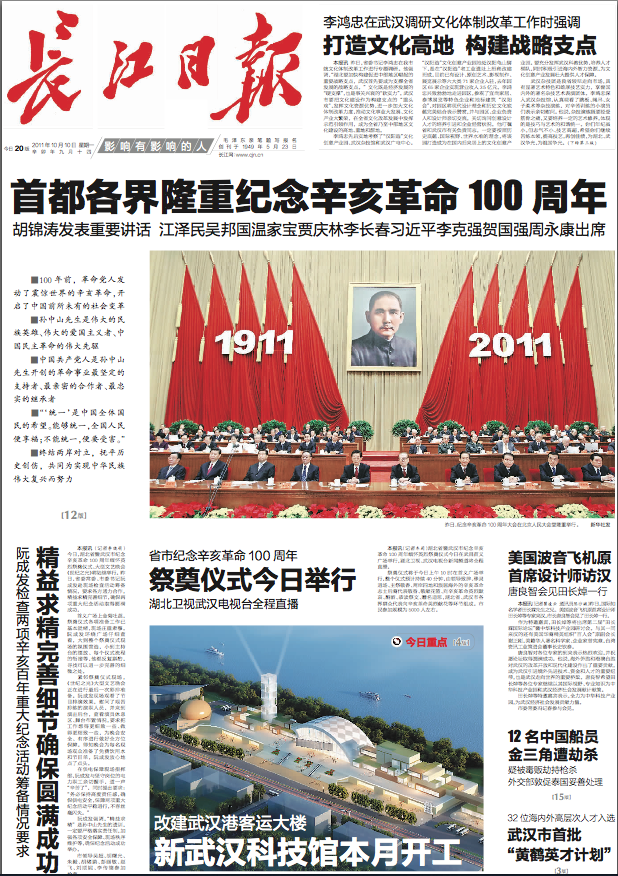

Both of the newspapers above differ from the People’s Daily in the way they have given the Xinhai Revolution commemoration story prominent position, but have offered only brief front page coverage, instead referring readers to the inside pages.
The upper right-hand corner of the Changjiang Daily front page has a story about cultural sector reforms in Wuhan. Below the fold are other local stories, including local coverage of the anniversary commemoration, and a story about a visit to Wuhan by a former chief engineer for Boeing.
But a handful of newspapers in China decided to pull their own news angles out of the Xinhai Revolution commemoration story. This was the case with major newspapers in southern Guangdong province, which has a reputation for slightly bolder media.
Nanfang Daily, the province’s official Party newspaper, opted for the same photograph of Hu Jintao and Jiang Zemin that was used by many foreign and Hong Kong media in their reports on internal Party power plays and Jiang’s role.
The large headline at Nanfang Daily draws from Hu Jintao’s remarks on cross-straits relations between mainland China and Taiwan: “Increasing a national spirit of sticking together through thick and thin; with one heart, realizing the rejuvenation of our people.”
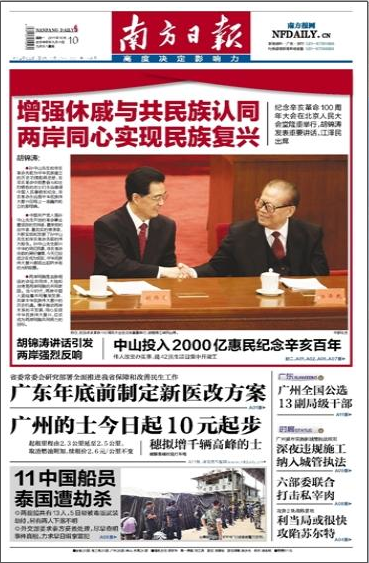
The front page of Southern Metropolis Daily, a commercial spin-off of Nanfang Daily regarded as one of China’s top professional publications, is much the same as that of its “mother paper” (母报). The main photo is of Hu Jintao and Jiang Zemin smiling and shaking hands. The headline again is about cross-straits relations, this time the portion about “one heart” quoting directly from Hu instead of paraphrasing: “With one heart, realizing the great rejuvenation of the Chinese people; this should become the common goal to work toward on both sides of the straits.”
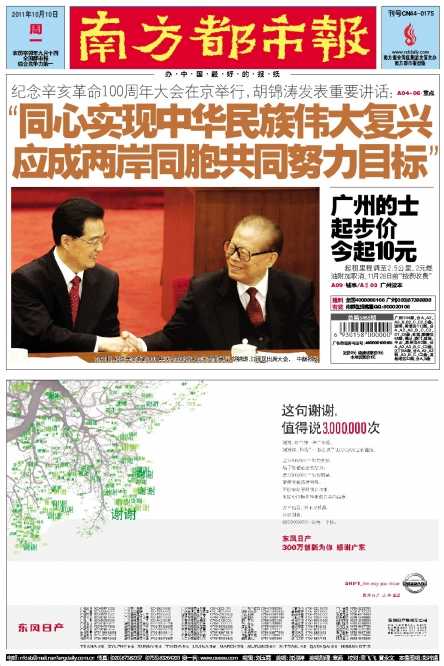
The headline at Southern Metropolis Daily in particular has a strange ring as it is juxtaposed with the photo of Hu and Jiang shaking hands. This is nothing more than the editor’s personal feeling here, but I couldn’t help but wonder if the newspaper wasn’t trying to slip in a bit of commentary about reaching across divides within the Party as well. (I welcome thoughts from native news junkies.)
But the starkest and most telling of contrasts may be offered by newspapers in Shanghai, China’s financial center, and of course the city from which Jiang Zemin emerged political in the aftermath of June 4, 1989. Here is the front page of Wen Hui Bao, the official newspaper of the Shanghai committee of the Chinese Communist Party — in other words, the “mouthpiece” of the city’s top Party leaders.

Wen Hui Bao is virtually a mirror image of the People’s Daily, austere and packed with official content. But here is today’s Oriental Morning Post, one of Shanghai’s leading commercial newspapers, which in recent years has also distinguished itself somewhat with its stronger investigative coverage and editorial page.

The headline is a tribute to the anniversary, not so different from the paper’s Party counterparts. It reads: “.” But the entire space below is swallowed by a brilliant advertisement for the luxury watch brand Rolex.
And in many ways, that says it all.

